And for the most part, those folks have been buying from German brands: the Audi Q5, BMW X3 and Mercedes-Benz GLC-Class. So, to show how the new RDX compares to them, Acura actually provided examples of each during the recent press drive along with a Volvo XC60. All were determined to have greater emotional appeal than the last RDX, and we would certainly agree. For, as much as the previous-generation RDX made sense on paper, it was really hard to get excited about it. And when you're paying extra for a luxury vehicle, shouldn't you get a little excited?
Well, as luck would have it, Consumer Editor Jeremy Korzeniewski and I were on hand in Whistler, British Columbia, for the press launch. We didn't have an abundance of time in each RDX competitor, but in conjunction with our usual comparison chart, our impressions should provide a good first taste of how the new RDX compares.
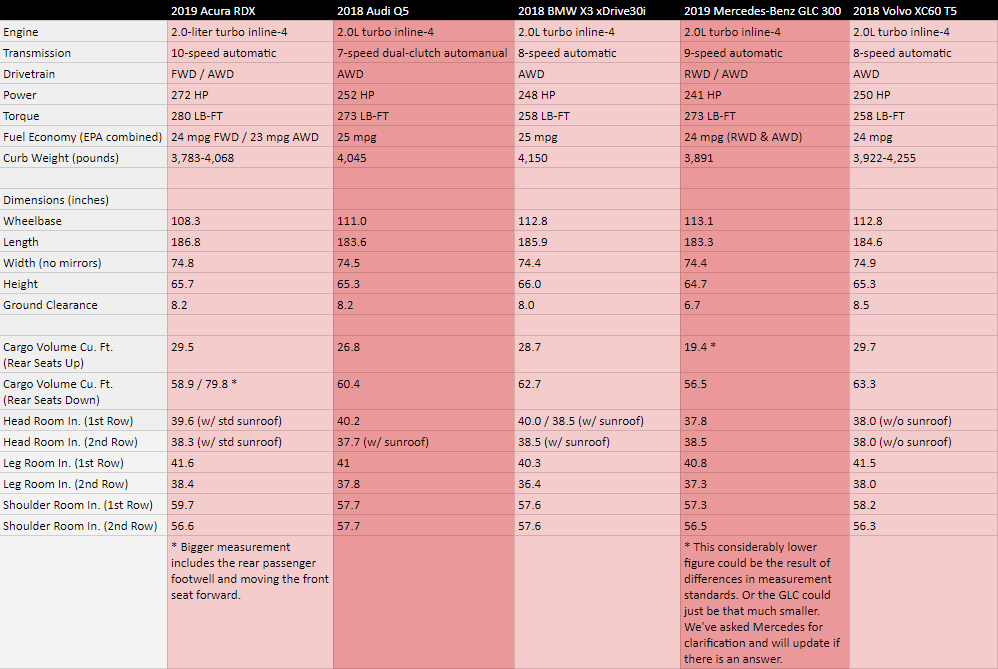
Performance and fuel economy
Contributing Editor James Riswick: On paper at least, the RDX is gutsier than its comparably powered European rivals. It also weighs the same or less, which logically should mean it'll be the quickest in a straight line. During my brief drives, though, I'm not sure it really stood taller than the three Germans. It at least matches them for smoothness, which is something that can't be said about the Volvo. Fuel economy is lower than them all when you consider all but the Mercedes come standard with all-wheel drive. It's also worth noting that all the competitors are available with engine upgrades, and unless Acura's forthcoming resurrection of Type S models includes the RDX, it should stay that way.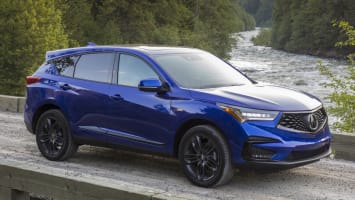
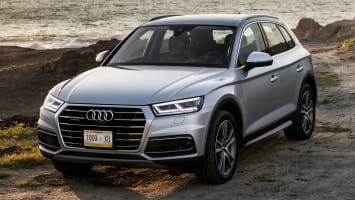
Consumer Editor Jeremy Korzeniewski: Line 'em all up in a drag race, and I have a feeling the Acura would squirt away to victory. A good bit of that, though, would be due to its 10-speed automatic transmission, which offers a huge spread of ratios and fires off extremely quick shifts. In the real world, I'd guess fuel economy will be similar across the board, so I'm willing to call that category a draw.
Of course, there's more to performance than straight-line acceleration. I think the Audi might be the smoothest vehicle in this comparison, so I'll let the RDX and Q5 share the performance win, followed by the BMW and Mercedes. The Volvo struck me as coarser than the rest, and it's a bit down on power when compared to the Acura, so the Swede falls into last place.
What they're like behind the wheel
JR: The thing that really stands out is that each of these SUVs has a distinctive feel and personality behind the wheel. These aren't me-too appliances where you could remove the badge from one, put it on another and not really notice a difference. This could really come down to personal preferences about steering, throttle response, ride comfort, driving position and just general seat-of-the-pants feel. It's therefore tough to say one is better, which probably means Acura succeeded with the RDX redesign since it leaves a much more lasting impression than its predecessor. It's now playing a different position in the same ballpark as the other players here, as opposed to playing in a different ballpark altogether.If I were doling out buying advice, I'd say, "Drive them all and see which one you like the best. There's no wrong answer." I wouldn't say that lightly, either, as I generally think such wishy-washy answers aren't helpful. If, however, I was choosing the one I liked to drive best, it would be the Mercedes. I may have slightly preferred certain elements of one of the others better, but the Benz felt the most "right" all around. If I were to rank them based on personal driving preference, I'd say Benz, Audi, Acura, Volvo, BMW. Yes, BMW steering is just such a letdown.
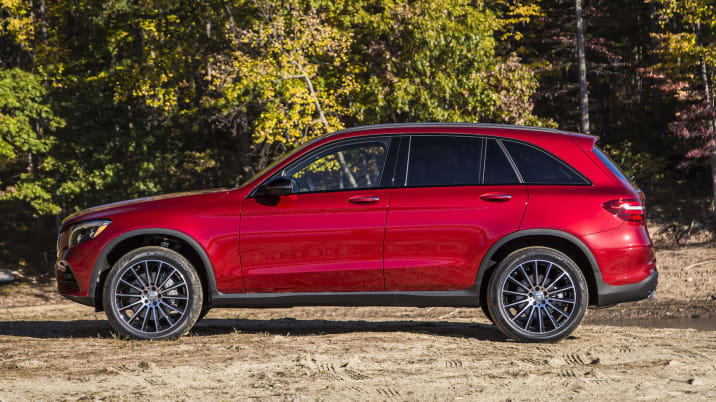

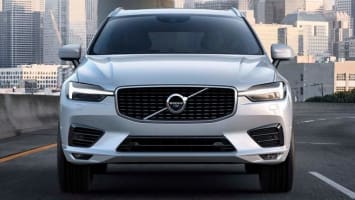
JK: I think the Mercedes feels more like an SUV than any of the other vehicles in this group, which could be good or bad, depending on what you're looking for. By way of contrast, the Audi drives like a really nice Golf (and I mean that as a compliment). Echoing what James said above, I'd suggest driving those two and then comparing them to the Acura, which really should be on your list by virtue of its excellent value proposition (more on that later). The Volvo feels more like an acquired taste than any of the other options here, and the BMW is in third place out of the three Germans.
Interior space and comfort
JR: On paper, you'll note that the RDX has the most rear legroom, and I can report than in practice, that is absolutely correct. I placed the driver seats of each compact SUV in my way-back seating position, then checked to see how much room was remaining in back. The results: The Acura had notably more than the Volvo, which had notably more than the BMW, which was fairly similar to the Mercedes and then the Audi. The last was surprising given that, on paper at least, it's mid pack. Remember, though, that measurements aren't a perfect indicator of interior space, since the driver and front seat adjustability/travel can alter things considerably.As for comfort, you're really in luck in this segment. Acura's new seat design that debuts in the RDX seemed impressive during our day of driving and now comes with additional adjustments in the Advance trim. However, if we're talking seats worth typing about, it's the Volvo. The Swedes have done them well forever, and those the XC60 are no different.
JK: I'd love to have a strong opinion on the comfort quotient of these five crossovers, but all of them felt about equal to me in the limited time I had with each of them. I'm not quite as tall as James, but I also did the rear-seat check by placing the front seat where I would if I were driving, and there were no knees on seatbacks when I sat behind my virtual self in any of them.
Cargo space
JR: At first glance, it could seem like the new RDX absolutely blows its competition out of the water with its maximum of 79.8 cubic feet of space. That's more than a Honda CR-V, for Pete's sake. Yet, not every cargo measurement is created equal, and Acura admits that number is achieved by including the rear seat footwell and by pushing the front passenger seat forward. When you just include the area above the cargo floor and fold-flat back seat, it's 58.9 cubic feet, or smaller than all but the GLC. The problem is, we're not sure exactly how the others in the segment were measured. We've put out inquiries to representatives of each of the brands here, including Acura, to help shed some light on the situation. Mercedes says it measures in the same way that resulted in the Acura's 58.9 number, and we wouldn't be surprised if the others do as well. Nevertheless, when we know more, we'll update this comparison.What is known, however, is that the RDX did get a bit bigger for 2019 behind its back seat, and its 29.5 cubic-feet of space there (no measurement trickery here) is better than all but the Volvo, which is basically equal. However, Acura provides something the others don't: a sizable and genuinely useful under-floor storage area. Better still, it was achieved without losing the spare tire, which was relocated under the car.
JK: Only one vehicle here has a cargo hold with a dedicated spot for a few bottles of wine, and that's the Acura RDX. So if that's in your shopping criteria, look no further.
Interior design and qauality
JR: To me, the previous RDX cabin was its main demerit relative its European competition (OK, so the robo-beak styling didn't do it any favors). It was just so drab, and its quality just wasn't luxurious enough. The new one is a big step forward in terms of both design and quality. Again, like the driving experience, this could come down to preference. Which do you think looks best? Which tech interface agrees with you the most? And in terms of quality, there's a difference among the vehicles this group, but I don't think the gap is that wide and I also don't think the Acura is anywhere close to bottom. (And for the record, I like the Volvo, thank you).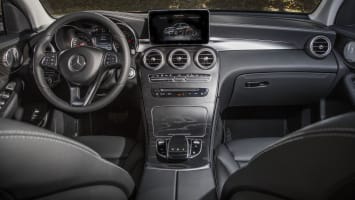
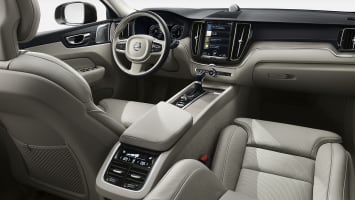
JK: Mercedes does overall interior design better than any other automaker right now, with the caveat that you've got to pay a pretty penny for the high-end Designo package. If interior style is of prime concern and money isn't, the GLC (above left) would be my recommendation. For those who are pinching a few more pennies, I really like the interior style of the Volvo XC60 (above right). It looks and feels classy, and all the materials are of high quality. Plus, I like the vertical orientation of Volvo's Sensus infotainment system and find it pretty easy to use once you know the swipes and button presses that make it work.
I also really like Audi's Virtual Cockpit (below left), which completely replaces traditional gauges with an LCD screen directly in front of the driver. But the rest of the Audi's interior looks a bit bland to my eyes, and the brand's MMI infotainment system isn't my favorite. The BMW (below middle) is also bland, but without the visual eye candy of Audi's Virtual Cockpit, so therefore again in last place.
And what of Acura? I'd rate the RDX (below right) over the BMW for sure, and somewhere alongside the Audi and Volvo in overall appearance. I had to get the hang of Acura's new touchpad interface, but once I did, it worked fine. In any case, just to include the RDX in the same breath as its German rivals is a major win for Acura.
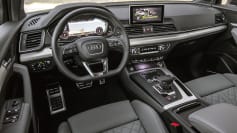
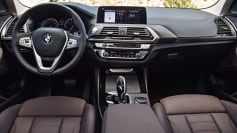
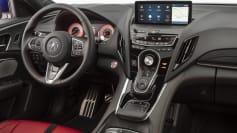
Value
JR: Ah, can we just agree that none of these come close to offering as much for your money as the Acura?JK: Yes. We can, and we do.
Conclusions
JR: The Acura still makes a ton of sense on paper, and now that it looks better, has a nicer interior and is more memorable to drive, there's definitely just as many emotional reasons to buy one. However, the problem with emotional considerations is that they usually come down to personal preference. And when you do that, I can't say I'd pick the Acura. My order would probably be a nail-biting choice between Mercedes or Volvo, then Acura, Audi (the styling does zero for me) and BMW (ditto, plus it has no great driving advantage).JK: I didn't get enough time behind the wheels of each of these vehicles to draw a final conclusion on my favorites. That said, I wouldn't have gone into a comparison of these small, premium crossovers thinking that that Acura would be on my shortlist, but it is. It's a logical choice due to its pricing strategy, and its driving dynamics are good enough to match its German (and Swedish) rivals. That's a major success for Acura no matter how you slice it.
Related Video:
Comments
Post a Comment